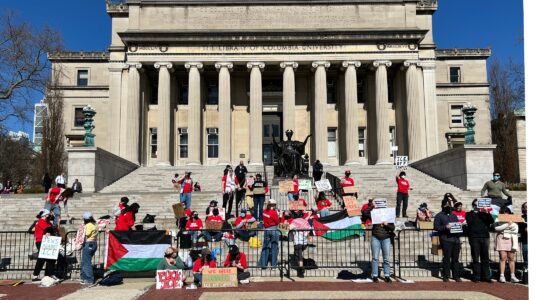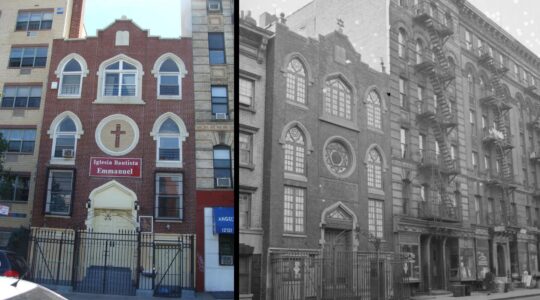Hurricane season ended last week, and the Caribbean breathed a sigh of relief.
Along the sandy beaches that are the calling card of Antigua, businesses welcomed the season’s first tourists with a special sense of mission. The two-island nation faces a painful, expensive rebuilding process after Antigua’s sister isle, Barbuda, was all but destroyed by Hurricane Irma last September.
Visiting Antigua this winter, then, is a win-win proposition. The struggling country gets a recovery boost from your tourism dollars. And tourists get to vacation on an island that offers a particularly good balance of natural beauty, English naval history and shopping — not just for duty-free goods, but also for colorful local art, ceramics and seashell handcrafts.
There isn’t a lot of Jewish history on Antigua, but when you stroll along the lapping turquoise shore, you gaze over the same mountains that greeted Sephardic merchants in the 17th and 18th centuries. As throughout the Caribbean, these adventurers left Iberian persecution to find opportunity in the burgeoning commodities of the West Indies, notably sugar and tobacco.
Most Antigua Jews eventually moved north to the United States, where they were instrumental in building early American Jewish communities. Given this trajectory, it’s fitting that the most famous Jew from Antigua is probably the novelist Jamaica Kincaid. Kincaid was born in the Antiguan capital, St. John’s, but didn’t become Jewish until she moved to the U.S., where she converted during her marriage to the composer Allen Shawn (son of New Yorker editor William, brother of actor Wallace).
East of Puerto Rico and the Virgin Islands, Antigua is wedged between St. Kitts & Nevis, Montserrat and Guadeloupe (tiny Barbuda is just north). Sephardic traders moved easily between nearby islands, and their visible legacy is more evident elsewhere.
With such a strategic position and favorable geography — a deep-water harbor at St. John’s, and miles of sandy beaches — Antigua has been a favorite of Europeans since Christopher Columbus named it in 1493 (Antigua is Spanish for “ancient”).
Centuries of British rule left Antigua and Barbuda with a passion for cricket and a habit of driving on the left. (The Brits did not, however, leave roads that compare with those in Great Britain: Antiguan potholes are legendary.)
Much of Antigua retains a distinctly British charm — a rusticity unspoiled by the high-rise overdevelopment rampant elsewhere in the Caribbean. To me, a lot of the buildings in St. John’s are reminiscent of those along the New England coast, except with brighter colors. From grand, clapboard-sided villas to weather-beaten shingle cottages, much of the streetscape would fit right in on Cape Cod.
Rugged stonework is an Old World signature in the precincts where Admiral Horatio Nelson once commanded the Royal Navy. English-style stone buildings, stone walls and moss-covered ramparts all contribute to a rustic landscape where history is tangible. Along the waterfront in St. John’s, rows of moldering black cannons remind you of this isle’s strategic importance.
A pleasant, if bumpy, drive through the island’s rugged green heart takes you south to English Harbour, a picturesque UNESCO Heritage site and one of the best-preserved historic districts in the Caribbean. Nelson’s Dockyard, as the principal attraction is known, was the Antiguan base of operations for the admiral and his fleet in the 1780s; in addition to being a national park, it’s still a working dockyard.
Prowl the ramparts, columns and lawns along the waterfront, visiting the Dockyard Museum for insight into Georgian naval history. Have lunch overlooking the harbor, where yachts have replaced the warships of yore, and then climb uphill to Shirley Heights.
Shirley Heights, Nelson’s onetime hilltop lookout, still offers some of the best views on Antigua. The vintage stone infrastructure has been gently updated with patio cafés; on weekend evenings, live steel band music turns the Heights into the island’s liveliest party, as dancers bounce and rum drinks flow.
Many find English Harbour to be the highlight of Antigua, but those with a car should venture east to Devil’s Bridge, a natural arch that rises out of the crashing Atlantic waves amid craggy rock formations. Popular among picnickers and Instagrammers, Devil’s Bridge is part of a spit of land — if you can call it that — that reaches into the wild blue ocean.
Antiguans like to boast that their island has 365 beaches, one for each day of the year. Their survival, after a particularly rough Caribbean summer, makes each pink winter sunset all the more special.
The New York Jewish Week brings you the stories behind the headlines, keeping you connected to Jewish life in New York. Help sustain the reporting you trust by donating today.




